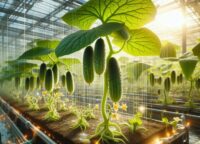
I’m Mitch and welcome to from roots to shoots i’m here to talk about a gardening adventure that’s both rewarding and practical. How to grow cucumbers in a greenhouse, and it comes with a nod from New Zealand. My partner and i, like countless others around the globe, seeks the joy and benefits of growing cucumbers in a versatile environment like a greenhouse. Regardless of where we call home, this undertaking transcends borders and climates, connecting us through a universal passion for gardening.
You’re going to find out how to create a little slice of greenhouse magic in your own backyard. This isn’t just about reaping the fruits of your labor; it’s also about embarking on a path toward self-sufficiency. Everyone can experience the thrill of controlling their own food source, and cucumbers, with their brisk, refreshing taste and plethora of nutrients, make an excellent starting point.
The enchantment of greenhouse gardening lies in its power to extend growing seasons and shield plants from the whims of nature. By creating an optimal environment for cucumbers, you’re taking an active role in the growth process, from germination right through to harvest. This level of involvement not only yields fresh produce but also nurtures a profound connection with the food that graces your table.
In the following section, ‘Why Grow Cucumbers in a Greenhouse?’ we’ll dive into the compelling reasons for choosing greenhouse cultivation over traditional methods. From the practical advantages of pest control and climate regulation to the sheer nutritional value of cucumbers, we’ll uncover why this approach is so beneficial. And, as Mitch from New Zealand knows well, it’s a step towards self-reliance that anyone, anywhere can take.
For more info on cucumbers check out this link
Why Grow Cucumbers in a Greenhouse?
You might be thinking, why pick cucumbers as my go-to greenhouse plant? I’m going to break it down for you. Growing cucumbers in a greenhouse isn’t just about yielding a crop; it’s about the plethora of advantages that come with it. First off, having a greenhouse allows you to extend the typical growing season. This means you can start your cucumbers early in the spring and keep them thriving well into the cooler months.
Aside from defying seasonal constraints, a greenhouse shields your cucumbers from common outdoor gardening woes. That’s right, we’re talking about pests and diseases. Greenhouse gardening minimizes the exposure your plants have to pests, leading to healthier plants and often reducing the need for chemical treatments.
But here’s the best part: cucumbers themselves. These crunchy, hydrating fruits are stacked with nutrients and are incredibly versatile in the kitchen. And let’s not forget the personal satisfaction and health benefits that come with home-growing your food. With cucumbers, you’re looking at a high vitamin content, including vitamin K, and they’re a fantastic source of hydration due to their high water content.
Making the shift toward growing your food can greatly contribute to being self-sufficient. Growing cucumbers can pave your path to this lifestyle since they’re prolific producers. You’ll often find that once your plants get going, there’s an abundance of produce, maybe even enough to share with neighbors and friends.
Now that you’re wrapped up in the ‘whys’ of growing cucumbers in a greenhouse, you’re going to want to focus on the ‘hows.’ And this includes choosing the right greenhouse for your garden sanctuary. High-quality cucumbers stem from the right environment, and that’s where we’ll head next.

Choosing the Right Greenhouse for Your Cucumbers
You might be itching to get your hands dirty and start planting, but first, let’s get you set up with the right greenhouse. It’s like picking out a new home for your plants; you want it to have everything they need to thrive. So, where do you begin? Consider your local climate and the amount of space you can dedicate to greenhouse gardening.
Not all greenhouses are created equal, and that’s especially true when it comes to growing cucumbers. In some places, a simple polytunnel will do, while in colder regions, you might need a fully insulated structure. Look for features like adjustable ventilation, which is crucial for managing humidity and temperature – both of which can significantly impact cucumber growth.
Your greenhouse should also be sturdy enough to support the climbing nature of cucumber plants. Make sure you have room for trellises or hanging baskets, which will not only help save space but also encourage healthy growth. Consider also the light requirements. Cucumbers love sunlight, so a greenhouse that maximizes light exposure will help in producing a bountiful harvest.
When choosing a greenhouse, it’s not just about today’s needs but also future expansions. Opt for a size that allows for the addition of more plants down the track, because once you taste the success of your first harvest, you’re going to want to grow more.

Cultivating Cucumbers: From Seed to Harvest
I’m here to help you with turning a tiny seed into a bountiful cucumber harvest in your greenhouse. You’ll have cucumbers ready for salads, pickling, or just a fresh, crunchy snack straight from the vine.
Choose something that resonates with you when it comes to cucumber varieties. There are slicing cucumbers for fresh eating, and pickling varieties for those homemade pickles you’ve been eager to try. Consider disease resistance and growth habit (bush or vining) when picking your seeds.
Let’s get those seeds started. Plant them in well-draining soil and keep the temperature inside the greenhouse consistently warm for optimal germination. Cucumber plants love light, so ensure they get plenty of it, but not too much direct sunlight that might scorch the young plants.
As the plants grow, you’re going to find out about the importance of trellising for vining varieties – it supports the plant and keeps the cucumbers off the ground. Regular watering is key, but don’t overdo it; consistent moisture without waterlogging the roots is the goal.
In my opinion, the most rewarding part is seeing those little yellow flowers turning into cucumbers. Pollination is crucial here, and while some varieties are self-pollinating, others might need a little help. If you don’t have natural pollinators in your greenhouse, you may need to manually pollinate the flowers.
If you want to avoid diseases and pests which can sometimes sneak into your greenhouse, be vigilant. Keep an eye out for common cucumber problems like powdery mildew or aphids, and take action quickly with organic solutions to keep your plants healthy.
Harvest your cucumbers regularly to encourage more fruiting; for most varieties, this means when they’re medium-sized and firm to the touch. Waiting too long can lead to bitter, overripe cucumbers.
Your first attempt doesn’t need to be your last, and with every season, you’ll learn more about the delightful nuances of growing cucumbers. Make notes of what works and what doesn’t, and adjust your approach for the next batch.
Beyond the Greenhouse: Enjoying and Sharing Your Cucumber Bounty
Now that you’ve nurtured your cucumbers from seedlings to fruitful vines, it’s time to revel in the abundance of your greenhouse labor. Crunchy, fresh, and packed with goodness, your home-grown cucumbers are ready to star in your meals and snacks. But this isn’t just about enjoying the harvest; it’s about broadening the impact of your efforts.
You’re going to find out about inventive recipes and preservation methods to maximize your cucumber yield all year round. From pickling to fermenting, the possibilities are endless. Choose something that resonates with you, whether it’s zesty dill pickles or a tangy tzatziki sauce.
And what about the surplus? Sharing is a beautiful aspect of gardening. Donate to food banks, gift to neighbors, or organize a produce swap. You’ll be surprised how your cucumbers can bring people together, foster connections, and spread the joys of gardening.
In my opinion, the beauty of growing your own food extends far beyond the individual. It’s a channel for community building and a step towards a more resilient food system. As you prepare for the next season, reflect on your journey towards self-sufficiency and how you can continue to grow — not just cucumbers, but relationships, knowledge, and a greener world.
Leave us comment
Happy gardening
Mitch
Follow to stay up to date with new posts!

Our website contains affiliate links. This means if you click and make a purchase, we may receive a small commission. Don’t worry, there’s no extra cost to you. It’s a simple way you can support our mission to bring you quality Gardening Tips.
Last Updated on February 12, 2025 by Mitch

